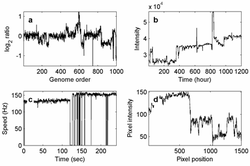Step detection

Step detection means figuring out when someone is taking a step while walking or running. When we walk or run, our bodies move a certain way each time we take a step. This might mean our feet hit the ground in a certain pattern, or our hips move in a particular way.
People who make apps or devices that track how much you walk or run often use step detection to keep track of how many steps you take.
To detect when someone takes a step, special sensors and software are used. These sensors might be in your phone or in a fitness tracker that you wear on your wrist. The software looks for patterns in the information that the sensors pick up.
For example, if you're wearing a fitness tracker and you take a step, your wrist might move in a particular way. The sensors in the tracker pick up this movement, and the software analyzes the pattern of data it receives. If it detects the pattern that means you're taking a step, it will count it as one step in your fitness tracker app.
Step detection can be tricky because other movements, like jumping or bouncing, can look similar to the motion of taking a step. But scientists and developers are always working to make step detection more accurate so that you can better track your movement and stay healthy!
People who make apps or devices that track how much you walk or run often use step detection to keep track of how many steps you take.
To detect when someone takes a step, special sensors and software are used. These sensors might be in your phone or in a fitness tracker that you wear on your wrist. The software looks for patterns in the information that the sensors pick up.
For example, if you're wearing a fitness tracker and you take a step, your wrist might move in a particular way. The sensors in the tracker pick up this movement, and the software analyzes the pattern of data it receives. If it detects the pattern that means you're taking a step, it will count it as one step in your fitness tracker app.
Step detection can be tricky because other movements, like jumping or bouncing, can look similar to the motion of taking a step. But scientists and developers are always working to make step detection more accurate so that you can better track your movement and stay healthy!
Related topics others have asked about:
